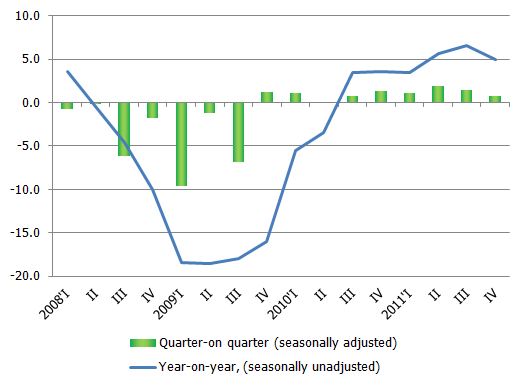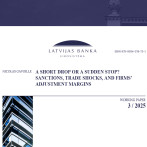Gross domestic product grows in the last quarter of last year as well
According to the flash estimate published by the Central Statistical Bureau, gross domestic product (GDP) grew 5.0% year-on-year at constant prices. According to seasonally adjusted data, GDP grew 0.8% quarter-on-quarter. Thus in 2011 overall, Latvian GDP has grown by approximately 5.3%, making Latvia's one of the most rapidly growing GDPs in the European Union.
In the last quarter of last year, GDP growth slowed down as predicted (1st Q – 1.2%; 2nd Q – 2.1%; 3rd Q. – 1.7%). The GDP growth in the fourth quarter was ensured by the successful manufacturing performance (production output volume +1.9%). The operational data on the transportation branch – cargo turnover in ports and on railroads – indicate that growth was substantial in this branch in the fourth quarter. A negative impact on GDP growth in the fourth quarter, however, was exerted by retail trade (retail trade turnover at constant prices: -0.9%) as well as by the energy and gas supply branch (production output volume: -5.0%).
In 2011 overall, the main drivers of the economy were the following:
- retail trade branch, which, on account of gradually increasing real wage bill and leasing portfolio (increase in the volume of automobiles sold) had moderate growth throughout the year;
- manufacturing branch, which, despite global developments, managed to increase production volumes;
- transportation branch, with ports and railroads functioning most successfully, reaching several historic highs in terms of cargo volumes transported and handled.
- The year was outstanding for accommodation and food service branch – this branch is likely to finish the year with the highest rate of annual growth.
What does the future hold? On the one hand, a clear resolution is yet to be found to the situation with Greece's huge debts and its possible impact on the European economy at large. The growth of European real economies is affected as well, which lessens the external demand of these countries for goods and services. The GDP flash indicators for the fourth quarter of 2011 in several countries have already pointed to a weaker development of the European economy. The Latvian economy cannot of course escape the impact of external developments entirely: the shrinking external demand will affect our economy.
On the other hand, the Latvian economy in 2011 has not shown any notable signs of slowing down and has been "on its own track". It is possible that the impact of the European problems on our economy will be somewhat delayed because historical evidence suggests that the Latvian economy lags slightly behind the European cycle of economic activity. The participants of the Latvian economy – industrialists, consumers, entrepreneurs et al. – tend to maintain a rather optimistic view both of the current situation and the future, however. The confidence indicators aggregated by the European Commission improved substantially in January and, compared to the other EU countries, the Latvian economic sentiment indicator (ESI) lags behind only that of Germany.
The expanded GDP data on the fourth quarter of 2011 and the year overall will become available on 9 March. Then it will become possible to have a more precise assessment of the growth promoting factors and perhaps some trends will become obvious, which will allow us to make safer predictions about 2012.
GDP dynamics, %

Textual error
«… …»






